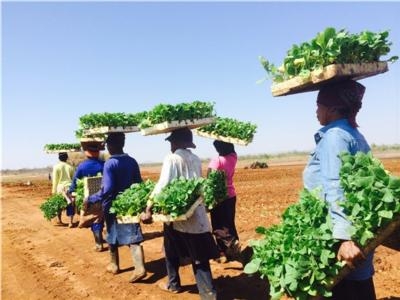Will Be Used To Make Sustainable Aviation Biofuel, Supports South Africa's Rural Economy
South African farmers will soon harvest their first crop of energy-rich tobacco plants, an important step towards using the plants to make sustainable aviation biofuel, according to Boeing and South African Airways (SAA). Experienced tobacco farmers will grow the plant, called Solaris, as a replacement for traditional tobacco.

Boeing and SAA, along with partners SkyNRG and Sunchem SA, also officially launched Project Solaris, their collaborative effort to develop an aviation biofuel supply chain with a nicotine-free tobacco plant called Solaris. In Limpopo province, company representatives and industry stakeholders visited commercial and community farms where 123 acres (50 hectares) of Solaris have been planted.
Oil from the plant’s seeds may be converted into bio-jet fuel as early as next year, with a test flight by SAA as soon as practicable.
“SAA continues to work towards becoming the most environmentally sustainable airline in the world and is committed to a better way of conducting business,” said Ian Cruickshank, Environmental Affairs Specialist, SAA Group. “The impact that the biofuel program will have on South Africans is astounding: thousands of jobs mostly in rural areas, new skills and technology, energy security and stability and macro-economic benefits to South Africa, and of course, a massive reduction in the amount of CO 2 that is emitted into our atmosphere.”
“It is very exciting to see early progress in South Africa towards developing sustainable aviation biofuel from energy-producing tobacco plants,” said J. Miguel Santos, managing director for Africa, Boeing International. “Boeing strongly believes that our aviation biofuel collaboration with South African Airways will benefit the environment and public health while providing new economic opportunities for South Africa’s small farmers. This project also positions our valued airline customer to gain a long-term, viable domestic fuel supply and improve South Africa’s national balance of payments.”
The farm visits followed the announcement in August that Boeing, SAA and SkyNRG were collaborating to make aviation biofuel from the Solaris plant, which was developed and patented by Sunchem Holding. If the test farming in Limpopo is successful, the project will be expanded in South Africa and potentially to other countries. In coming years, emerging technologies are expected to increase aviation biofuel production from the plant’s leaves and stems.
Sustainable aviation biofuel made from Solaris plants can reduce lifecycle carbon emissions by 50 to 75 percent, ensuring it meets the sustainability threshold set by the Roundtable on Sustainable Biomaterials (RSB). Airlines have conducted more than 1,600 passenger flights using aviation biofuel since the fuel was approved for commercial use in 2011.
Boeing is the industry leader in global efforts to develop and commercialize sustainable aviation biofuel. In addition to its collaboration in Southern Africa, Boeing has active biofuel development projects in the United States, Middle East, Europe, China, Japan, Southeast Asia, Brazil and Australia.
(Image provided by Boeing: Tobacco farm workers in Marble Hall, South Africa, carry Solaris seedlings from a nursery to the field)
 ANN's Daily Aero-Term (05.17.24): Very High Frequency
ANN's Daily Aero-Term (05.17.24): Very High Frequency ANN's Daily Aero-Linx (05.17.24)
ANN's Daily Aero-Linx (05.17.24) ANN FAQ: Submit a News Story!
ANN FAQ: Submit a News Story! Classic Aero-TV: ANN Visits Wings Over The Rockies Exploration Of Flight
Classic Aero-TV: ANN Visits Wings Over The Rockies Exploration Of Flight Airborne Affordable Flyers 05.16.24: PRA Runway, Wag-Aero Sold, Young Eagles
Airborne Affordable Flyers 05.16.24: PRA Runway, Wag-Aero Sold, Young Eagles



